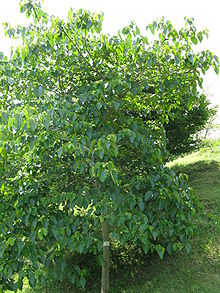Tung tree
| Vernicia fordii | |
|---|---|
 |
|
| Scientific classification | |
| Kingdom: | Plantae |
| (unranked): | Angiosperms |
| (unranked): | Eudicots |
| (unranked): | Rosids |
| Order: | Malpighiales |
| Family: | Euphorbiaceae |
| Genus: | Vernicia |
| Species: | V. fordii |
| Binomial name | |
|
Vernicia fordii (Hemsl.) Airy Shaw |
|
| Synonyms | |
|
Aleurites fordii Hemsl. |
|
Aleurites fordii Hemsl.
Vernicia fordii, usually known as the tung tree (Chinese: , tóng) is a species of Vernicia in the spurge family native to southern China, Burma, and northern Vietnam. It is a small to medium-sized deciduous tree growing to 20 m tall, with a spreading crown. The bark is smooth and thin, and bleeds latex if cut. The leaves are alternate, simple, 4.5–25 cm long and 3.5–22 cm broad, heart-shaped or with three shallow, maple-like lobes, green above and below, red conspicuous glands at the base of the leaf, and with a 5.5–26 cm long petiole. The flowers are 2.5–3.5 cm diameter, with five pale pink to purple petals with streaks of darker red or purple in the throat; it is monoecious with individual flowers either male or female, but produced together in the inflorescences. The flowers appear before or with the leaves in loose, terminal clusters. The fruit is a hard, woody pear-shaped berry 4–6 cm long and 3–5 cm diameter, containing four or five large, oily seeds; it is green initially, becoming dull brown when ripe in autumn.
Other vernacular names include the tung-oil or tungoil tree (), the kalo nut tree, and the China wood-oil tree.
The tung tree is valued for tung oil, which is derived from the seeds of the tree. Tung oil, also called China wood oil or nut oil, has traditionally been used in lamps in China. In modern times, it is used as an ingredient in paint, varnish, and caulk. It is also used as a wood finish for furniture and other wooden objects. After processing to remove gums in the oil, it was also used as a motor fuel.Marco Polo wrote in the 13th century "The Chinese take some lime and chopped hemp, and these they knead together with a certain wood oil; and when the three are thoroughly amalgamated they hold like any glue, and with this mixture they paint their ships".
...
Wikipedia
